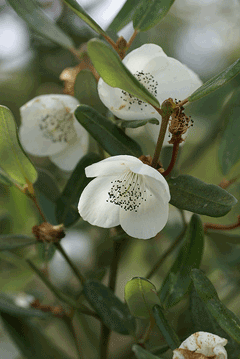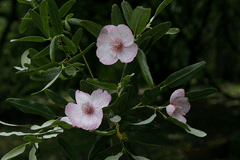 |
|
http://flickr.com/photos/63276845%40N00/ |
 |
| http://flickr.com/photos/8108294%40N05/ |
Translate this page:
Summary
Physical Characteristics

 Eucryphia lucida is an evergreen Tree growing to 10 m (32ft) by 4 m (13ft) at a medium rate.
Eucryphia lucida is an evergreen Tree growing to 10 m (32ft) by 4 m (13ft) at a medium rate.
See above for USDA hardiness. It is hardy to UK zone 8. It is in leaf all year, in flower from June to July. The species is hermaphrodite (has both male and female organs) and is pollinated by Bees.
Suitable for: light (sandy), medium (loamy) and heavy (clay) soils. Suitable pH: mildly acid and neutral soils. It can grow in semi-shade (light woodland) or no shade. It prefers moist soil.
UK Hardiness Map
US Hardiness Map
Synonyms
E. billardieri. Carpodontos lucida.
Plant Habitats
Woodland Garden Secondary; Hedge;
Edible Uses
References More on Edible Uses
Medicinal Uses
Plants For A Future can not take any responsibility for any adverse effects from the use of plants. Always seek advice from a professional before using a plant medicinally.
Antiseptic Styptic
Antiseptic, styptic[152].
References More on Medicinal Uses
The Bookshop: Edible Plant Books
Our Latest books on Perennial Plants For Food Forests and Permaculture Gardens in paperback or digital formats.

Edible Tropical Plants
Food Forest Plants for Hotter Conditions: 250+ Plants For Tropical Food Forests & Permaculture Gardens.
More

Edible Temperate Plants
Plants for Your Food Forest: 500 Plants for Temperate Food Forests & Permaculture Gardens.
More

More Books
PFAF have eight books available in paperback and digital formats. Browse the shop for more information.
Shop Now
Other Uses
References More on Other Uses
Cultivation details
Requires an open but sheltered position and a light moist lime-free soil[11, 184]. Succeeds in any free open loamy soil[1]. Prefers its base in the shade with its canopy in the light[200]. Requires plenty of light if it is to flower freely, tolerating almost full sun if the soil is cool and moist[11]. Strongly resents dryness at the roots during the growing season[125]. Requires a sheltered position when grown in the colder areas of the country[200]. This species is hardy to about -10°c[184], succeeding outdoors in the milder areas of Britain south and west of London[11]. The leaves and young shoots are very resinous[11]. The honey-like perfume of the flowers pervades the air for some considerable distance[245]. Hybridizes with other members of this genus[200]. A good bee plant[156, 166]. Some named forms have been selected for their ornamental value[184].
References Carbon Farming Information and Carbon Sequestration Information
Temperature Converter
Type a value in the Celsius field to convert the value to Fahrenheit:
Fahrenheit:
The PFAF Bookshop
Plants For A Future have a number of books available in paperback and digital form. Book titles include Edible Plants, Edible Perennials, Edible Trees,Edible Shrubs, Woodland Gardening, and Temperate Food Forest Plants. Our new book is Food Forest Plants For Hotter Conditions (Tropical and Sub-Tropical).
Shop Now
Plant Propagation
Seed - sow February in a greenhouse. The seed should be stored cool and dry over the winter. Germination is usually good[78]. When they are large enough to handle, prick the seedlings out into individual pots and grow them on in the greenhouse for at least their first winter. Plant them out into their permanent positions in late spring or early summer, after the last expected frosts. Cuttings of half-ripe wood, 6 - 8cm with a heel, June/July in individual pots in a frame. Roots in 5 - 6 weeks. A variable percentage succeed[78]. Layering in late summer. Takes 16 months. High percentage[78].
Other Names
If available other names are mentioned here
Native Range
AUSTRALASIA: Australia (Tasmania)
Weed Potential
Right plant wrong place. We are currently updating this section.
Please note that a plant may be invasive in one area but may not in your area so it's worth checking.
Conservation Status
IUCN Red List of Threatened Plants Status :

Growth: S = slow M = medium F = fast. Soil: L = light (sandy) M = medium H = heavy (clay). pH: A = acid N = neutral B = basic (alkaline). Shade: F = full shade S = semi-shade N = no shade. Moisture: D = dry M = Moist We = wet Wa = water.
Now available:
Food Forest Plants for Mediterranean Conditions
350+ Perennial Plants For Mediterranean and Drier Food Forests and Permaculture Gardens.
[Paperback and eBook]
This is the third in Plants For A Future's series of plant guides for food forests tailored to
specific climate zones. Following volumes on temperate and tropical ecosystems, this book focuses
on species suited to Mediterranean conditions—regions with hot, dry summers and cool, wet winters,
often facing the added challenge of climate change.
Read More
Expert comment
Author
(Labill.)Baill.
Botanical References
11200
Links / References
For a list of references used on this page please go here
Readers comment